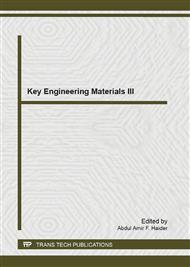p.3
p.8
p.12
p.17
p.23
p.28
p.32
p.37
Development of Concrete Mix Design Nomograph Containing Polyethylene Terephtalate (PET) as Fine Aggregate
Abstract:
This paper describes the experimental investigation to develop the concrete mix design Nomograph for concrete containing PET as fine aggregate. The physical and mechanical properties were determined by using mix proportion containing 25%, 50% and 75% of PET with water cement ratio (w/c) 0.45, 0.55 and 0.65. The data obtained showed that the inclusion of PET aggregate reduce the strength performances of concrete. All the data obtained were combined into one single graph to develop a preliminary mix design nomograph for PET concrete. The nomograph consist of ; relationship between compressive strength and water cement ratio; relationship between splitting tensile strength water cement ratio; relationship between splitting tensile strength and PET percentage and relationship between compressive strength and PET percentage. The mix design nomograph can be used to assists in selecting the proper mix proportion parameters based on the criteria required.
Info:
Periodical:
Pages:
12-16
Citation:
Online since:
May 2013
Price:
Сopyright:
© 2013 Trans Tech Publications Ltd. All Rights Reserved
Share:
Citation:


